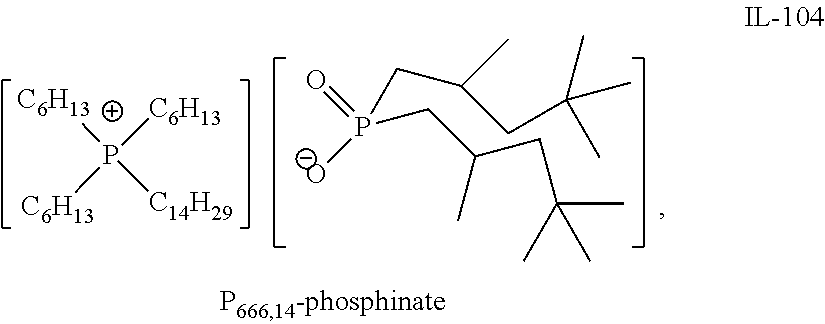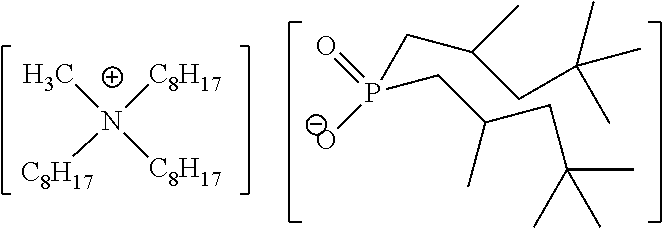Quaternary Phosphinates with Co-Solvents for Extracting C1 to C4 Carboxylic Acids from Aqueous Streams
- Summary
- Abstract
- Description
- Claims
- Application Information
AI Technical Summary
Benefits of technology
Problems solved by technology
Method used
Image
Examples
example 1
Extraction of Acetic Acid Using Non-Ionic Solvents
[0105]Tie line data at both high (typically around 16-20 wt % of HOAc in the organic phase) and low acetic acid concentrations (typically around 1 to 5 wt % of HOAc in the organic phase) were measured for each solvent at the temperature given in Table 2.
[0106]Roughly equal masses of water and solvent were added to a glass vial. Acetic acid was added to the solvent-water mixture in amounts sufficient to yield either high or low acid concentration data. Once the acetic acid was added, the mixture was agitated vigorously, and subsequently was allowed to separate into clear phases while maintaining the specified temperature. Each phase was sampled and analyzed by gas chromatography for water and acetic acid weight percent.
[0107]These data were used to calculate partition coefficients, with the controlling partition coefficient, Pcont, taken as the lesser of the partition coefficients at high and low acid concentrations. The data were als...
example 2
Extraction of Acetic Acid Using Phosphate Ester Solvents
[0109]Tie line data at both high (typically around 15-20 wt % of HOAc in the organic phase) and low acetic acid concentrations (typically around 1 to 2 wt % of HOAc in the organic phase) were measured for each solvent (either a pure phosphate ester or a mixture of phosphate ester with a co-solvent) at the temperature given in Table 3.
[0110]Roughly equal masses of water and solvent were added to a glass vial. Acetic acid was added to the solvent-water mixture in amounts sufficient to yield either high or low acid concentration data. Once the acetic acid was added, the mixture was agitated vigorously, and subsequently was allowed to separate into clear phases while maintaining the specified temperature. Each phase was sampled and analyzed by gas chromatography for water and acetic acid weight percent.
[0111]These data were used to calculate partition coefficients, with the controlling partition coefficient, Pcont, taken as the les...
example 3
Extraction of Acetic Acid Using Cyanex 923
[0113]Cyanex 923 is a commercially available mixture of trihexyl and dioctyl phosphine oxides.
[0114]Tie line data at both high (typically around 15-20 wt % of HOAc in the organic phase) and low acetic acid concentrations (typically around 1 to 2 wt % of HOAc in the organic phase) were measured for each solvent (either commercially available Cyanex 923 or a mixture of Cyanex 923 with a co-solvent) at the temperature given in Table 4.
[0115]Roughly equal masses of water and solvent were added to a glass vial. Acetic acid was added to the solvent-water mixture in amounts sufficient to yield either high or low acid concentration data. Once the acetic acid was added, the mixture was agitated vigorously, and subsequently was allowed to separate into clear phases while maintaining the specified temperature. Each phase was sampled and analyzed by gas chromatography for water and acetic acid weight percent.
[0116]These data were used to calculate parti...
PUM
| Property | Measurement | Unit |
|---|---|---|
| Percent by mass | aaaaa | aaaaa |
| Percent by mass | aaaaa | aaaaa |
| Percent by mass | aaaaa | aaaaa |
Abstract
Description
Claims
Application Information
 Login to View More
Login to View More - R&D
- Intellectual Property
- Life Sciences
- Materials
- Tech Scout
- Unparalleled Data Quality
- Higher Quality Content
- 60% Fewer Hallucinations
Browse by: Latest US Patents, China's latest patents, Technical Efficacy Thesaurus, Application Domain, Technology Topic, Popular Technical Reports.
© 2025 PatSnap. All rights reserved.Legal|Privacy policy|Modern Slavery Act Transparency Statement|Sitemap|About US| Contact US: help@patsnap.com



